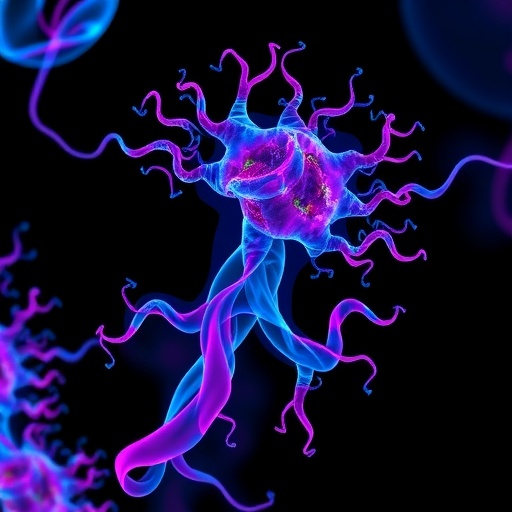Toll/interleukin-1 receptor (TIR) domain-containing proteins have long been recognized as critical components of immune signaling pathways across diverse organisms, orchestrating defense mechanisms that protect cells from pathogenic threats. These proteins, pivotal in both plant and animal systems, function enzymatically by cleaving nicotinamide adenine dinucleotide (NAD⁺), a ubiquitous coenzyme involved in redox reactions and cellular metabolism. Their NADase activity not only mediates immune response activation but also influences cellular homeostasis through complex molecular signaling routes. Despite extensive study, the regulatory mechanisms controlling TIR domain activity have remained enigmatic, leaving a crucial gap in our understanding of immune signaling modulation.
Recent breakthrough research has elucidated a previously unappreciated regulatory layer: phosphorylation of a highly conserved serine residue proximal to the catalytic glutamate within TIR domains acts as a molecular switch that inhibits the NADase enzymatic function. This discovery provides a striking mechanistic insight that bridges regulatory pathways in both plant and animal kingdoms. Phosphorylation serves as a post-translational modification that fine-tunes protein function by modifying structural and electronic environments, thereby modulating enzymatic activities with exquisite precision. Here, researchers demonstrate that the catalytic NAD⁺-cleaving event is dependent on integrity and accessibility of this conserved serine residue, rendering it a prime target for regulatory phosphorylation.
In plants, TIR activation is a double-edged sword; while it is crucial for defense activation, unrestrained activity induces programmed cell death and significantly inhibits growth, particularly under environmental challenges such as osmotic stress. This stress-induced growth repression represents an evolutionary trade-off between survival and development. The present study reveals how calcium-dependent protein kinases (CPKs), which are activated under osmotic stress conditions, phosphorylate the serine residue on plant TIR domains. This phosphorylation event effectively suppresses the NADase activity, thereby preventing excessive immune activation and enabling sustained growth despite stressful environmental conditions.
.adsslot_mQH58aqtjY{width:728px !important;height:90px !important;}
@media(max-width:1199px){ .adsslot_mQH58aqtjY{width:468px !important;height:60px !important;}
}
@media(max-width:767px){ .adsslot_mQH58aqtjY{width:320px !important;height:50px !important;}
}
ADVERTISEMENT
Remarkably, this regulatory phosphorylation mechanism is conserved in animals, highlighting an evolutionary convergence in immune signaling control. The mammalian calcium/calmodulin-dependent protein kinase II delta (CAMK2D), along with TANK-binding kinase 1 (TBK1), similarly targets TIR domains within animal immune components, including the sterile alpha and TIR motif–containing protein 1 (SARM1). SARM1 is well-known for its role in promoting axon degeneration following injury, mediated by its NADase activity. Phosphorylation by CAMK2D and TBK1 inhibits this activity, thus modulating neurodegenerative processes and maintaining cellular integrity. This cross-kingdom conservation underscores the fundamental importance of phosphorylation-mediated TIR regulation.
At the biochemical level, the serine residue in question is spatially adjacent to the catalytic glutamate that is central to NAD⁺ cleavage. This spatial arrangement suggests a direct influence on the active site conformation or substrate accessibility. Phosphorylation introduces a negative charge that likely induces conformational changes disrupting catalytic efficiency or substrate binding. The elegant structural coupling of catalytic and regulatory sites within TIR domains provides a sophisticated mechanism whereby cells rapidly adjust immune signaling outputs in response to intracellular and extracellular cues.
The study utilized a combination of advanced molecular biology techniques including site-directed mutagenesis to identify the indispensability of the conserved serine residue, in vitro kinase assays demonstrating direct phosphorylation by CPKs, CAMK2D, and TBK1, and in vivo functional assays across plant and animal models. These methods collectively illuminated the causative link between phosphorylation status and NADase activity, solidifying the role of this modification as a pivotal regulator of TIR domain function.
Furthermore, the discovery extends our comprehension of immune signaling by highlighting a unified regulatory theme conserved across kingdoms, which alters previous paradigms stating that plant and animal immune pathways are discretely controlled. This shared regulatory circuitry prompts reconsideration of evolutionary trajectories that have shaped innate immune mechanisms and suggests potential translational avenues in agriculture and medicine.
From an agricultural perspective, manipulating TIR phosphorylation states could be exploited to engineer crops with enhanced resilience that withstand osmotic and other abiotic stresses without the yield penalties typically associated with immune activation. Modulation of CPK activity or phosphorylation mimicry could fine-tune immune responses, preserving growth while sustaining defense. Conversely, in the context of human health, targeting TBK1 or CAMK2D-mediated phosphorylation pathways may provide novel strategies to modulate SARM1-driven neurodegeneration, with implications for traumatic nerve injury or neurodegenerative diseases.
This profound insight into TIR domain regulation opens new avenues for research aimed at unraveling the complete signaling networks governing phosphorylation-dependent immune modulation. Questions remain regarding the dynamics of kinase activation under varying physiological scenarios, the interplay with other post-translational modifications, and the potential involvement of phosphatases that reverse serine phosphorylation to reactivate TIR NADase functions.
Moreover, understanding the structural consequences of serine phosphorylation at atomic resolution through high-resolution crystallography or cryo-electron microscopy could yield detailed mechanistic models, paving the way for the rational design of small molecules that mimic or inhibit this modification. Such molecules could serve as tools or leads in agricultural biotechnology or clinical therapeutics, representing a promising frontier at the interface of basic biology and applied sciences.
Collectively, this study illuminates a fundamental biochemical checkpoint that governs TIR domain-mediated immune signaling, embodying a sophisticated evolutionary solution to balance defense and survival across life’s domains. The conservation of this phosphorylation-dependent inhibition underscores the universality of molecular principles underlying immunity and highlights the intricate interplay between enzymatic activity and post-translational modifications in cellular homeostasis.
Subject of Research: Regulation of Toll/interleukin-1 receptor (TIR) domain NADase activity by phosphorylation in plant and animal immune signaling.
Article Title: TIR immune signalling is blocked by phosphorylation to maintain plant growth.
Article References:
Li, J., Chen, S., Yu, B. et al. TIR immune signalling is blocked by phosphorylation to maintain plant growth. Nat. Plants (2025). https://doi.org/10.1038/s41477-025-02012-x
Image Credits: AI Generated
Tags: cellular homeostasis and immune defenseenzymatic function modulationimmune signaling pathwaysmechanistic insight into immune modulationmolecular switch in TIR proteinsNADase activity in immune responsephosphorylation as regulatory mechanismplant and animal immune systemspost-translational modification in signalingredox reactions in cellular metabolismserine residue in TIR domainsTIR domain-containing proteins





